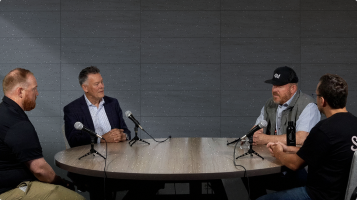An Overview of Underground Utility Locating: How it Works and Common Methods
Written by

Published on
October 11, 2023


Table of contents
Introduction to Underground Utility Locating
Avoiding utility strikes is at the top of the priority list for professionals involved in construction, excavation, and infrastructure development. In this article, we’ll look at common methods of underground utility locating, how they work, and why they’re so important.
Click the links below to jump to what you need:
- Significance of Accurate Utility Locating
- How Underground Utility Locating Works
- Common Methods of Underground Utility Locating
- Importance of Professional Utility Locators
Significance of Accurate Utility Locating
Accidental utility damage is both costly and dangerous. According to the Common Ground Alliance, more than 450,000 utility strikes happen every year in the United States. Some strikes can be deadly. “According to the Federal Housing Administration, it’s the biggest source of risk on civil engineering projects, causing hundreds of deaths and thousands of injuries,” says geospatial technology expert Geoff Zeiss in a 2022 episode of 4M Utility Strategy Podcast.
Even when they don’t cause physical harm to onsite workers, utility strikes trigger steep and unexpected expenses—up to $30 billion in total each year—and cause project delays.
That’s why locating underground utilities before a project begins is essential—but it’s not always a straightforward process.
How Underground Utility Locating Works
Utility locators, often contracted by One-Call/811 centers in their region, utilize a variety of utility locating equipment to identify and mark the location of underground infrastructure.
Typically, a locator crew is called to a site where excavation is planned. They first assess the area to decide which methods and equipment will be most accurate depending on the terrain and suspected types of underground facilities. The two most common types of utility locating tools are electromagnetic locators (EM) and ground penetrating radar (GPR). For some applications, acoustic methods can also be helpful.
Electromagnetic (EM) locators
EM locators utilize an electromagnetic radio frequency transmitter and receiver to identify utility lines. The transmitter sends out a radio signal in a specific frequency, which transmits through the conductive material in an underground pipe or other piece of infrastructure. For example, applying the signal to an above-ground entity such as a fire hydrant would allow the locator to trace the water line it’s connected to beneath the surface.
Ground penetrating radar (GPR)
GPR sends a radio signal into the ground and detects the echoes that bounce back from objects beneath the surface. GPR scanners can create images of underground objects without requiring any digging.
Acoustic Methods
While less common, acoustic locators can be used to detect infrastructure—such as plastic pipes—that are more difficult to pinpoint using other methods. An acoustic pipe locator sends sound waves into the ground and detects the reflected signal from the buried infrastructure.
Common Methods of Underground Utility Locating
Let’s take a closer look at each of these methods for underground utility identification.
Electromagnetic (EM) Locating
EM locators work by detecting electromagnetic signals radiating from pipes or cables, rather than detecting the lines themselves. Depending on the situation, EM locators can utilize one of several approaches:
- Direct connection
To do this, the locator’s transmitter can apply an electromagnetic current directly to a pipe, if part of it is within reach (examples of this include a hydrant equipped with a tracer wire, a utility vault, or valve). The crew then connects a second lead to the ground and adjusts the transmitter’s power and frequency to match that of the utility line, allowing them to trace the target line only—and with excellent accuracy. Because of its accuracy, direct connection is the preferred method for EM locating, but it requires part of the pipe to be exposed and only works with metallic lines.
- Ring Clamp
When a utility line has no exposed access point for a direct connection, EM locators can use an inductive ring clamp instead. The clamp is fastened to a metal cable or pipe. The transmitter then sends a signal to a coil inside the clamp, which relays that signal onto the target line. By coordinating the receiver’s frequency with the transmitter’s, the crew can locate and trace the path of the line in question. While the ring clamp induction method isn’t quite as accurate as a direct connection, it’s helpful for locating lines at midpoints and for tracing cable television and internet lines without interrupting service.
- Induction
In situations where there can be no metal-to-metal connection to the utility line, locators can use the induction method. They place the transmitter just above where they think the utility line lies and send out a signal to locate it. Once they identify the line, they can use the receiver to follow its frequency and trace its path. If there are few metallic underground pipes in the area, the induction method can work well—but if there are many other lines nearby, it can be challenging for locators to differentiate one line’s signal from another.
Ground-Penetrating Radar (GPR)
GPR utilizes electromagnetic radar pulses to find and trace subsurface utility lines. The GPR transmitter sends a tiny pulse of electromagnetic energy into the ground, which passes through objects under the surface and is distorted by conductive and dielectric properties. The receiving antenna receives the reflecting pulse and reads the signal distortions, displaying contrasts between objects below the surface along with depth information. The electromagnetic pulses a GPR transmitter creates can travel through many types of materials, and each one will impact the way the signal is reflected. This makes it a versatile tool for locating non-metallic utility lines such as PVC, plastic, and concrete pipes.
Acoustic Methods and Other Techniques
Because EM locators and GPR both have limitations, innovators have developed other techniques such as acoustic methods that send carefully designed patterns of sound waves into the soil. A highly sensitized receiver analyzes the time it takes the sound waves to bounce back, using the data to calculate depth. Acoustic methods can be successful in diverse conditions—including asphalt, sandy soil, and wet ground—that lessen the effectiveness of GPR.
For instances where physical access to a utility line is required, vacuum excavation provides a non-destructive method to reach the pipe or cable. Using special machinery, operators send a blast of air or water into the ground. Then, the loosened soil is removed with an air vacuum, clearing a path of access to the line.
Importance of Professional Utility Locators
Because accuracy is essential, utility locators need to be well-trained and skilled in using a variety of technologies to discover and trace subsurface utility lines. Certified technicians, such as subsurface utility engineering (SUE) professionals, play a key role in ensuring reliable results because they cast a wide net—locating all utility lines in a given area, both active and abandoned.
As new technologies emerge and utilities choose to share more information, reliable utility mapping will play a pivotal role in subsurface utility location, driving greater efficiency and accuracy. “Today, every contractor knows they have an underground utility location problem,” says Zeiss. “The U.S. spends $10 billion per year finding underground utilities with regional One-Call centers and locators. Creating a mechanism to capture and share information will yield a big payback.”
Conclusion
Everyone wants to avoid utility strikes—and locating underground utilities before excavation begins is the best way to avoid disaster. Utilizing a variety of technologies and equipment, along with accurate utility mapping, can help construction professionals ensure safety and success on their projects.
Recent blog posts

Our Newsletter
Join 7k infrastructure professionals
Get monthly insights on ways to build smarter, faster and safer with Utility AI.

.avif)




